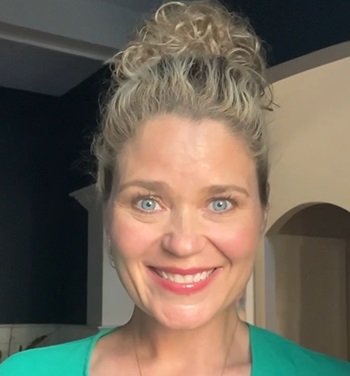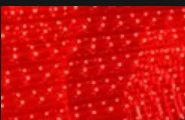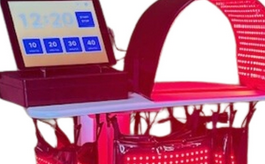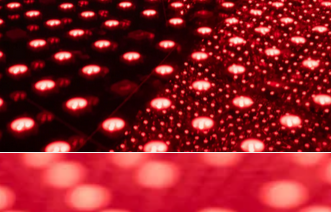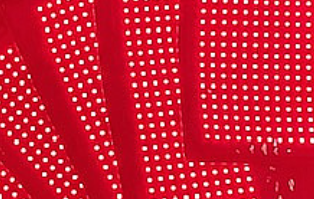Ask for Sue Open 8am-8pm 1-888-547-5296 |
DiscountRedLights.com.
... as I had paid too much and was misinformed for my first led light units...
|
Ask for Brian Open 8am-8pm 1-888-547-5296 |
Envy Capsule by Lightwave - Good Red Light Beds But Has Other Issues
This red light bed is really good. They come in the same league as NovoTHOR and Lightstim, when I analyze the real-life usage experiences on this. There are other issues though, that I discuss later on this page.
Below is what the bed looks like - pretty cool. The unit has 24,000 LED diodes, which makes it pretty strong too. This was also one of the first red light beds to provide full encapsulation, which is, getting the entire body including the face under the red light work area, leading to faster burnout sessions. Faster burnout makes this red light bed desirable by clinics that require faster turnaround.
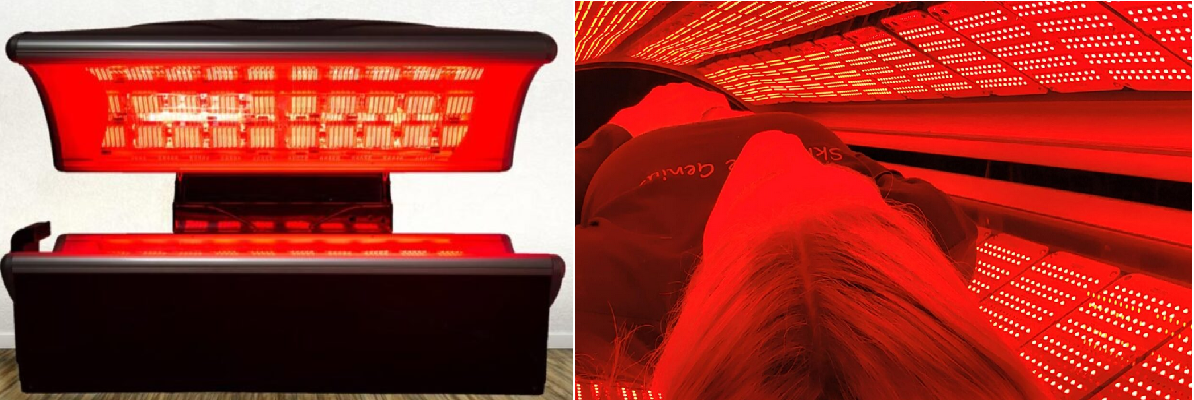
As you see in the picture above, it is a canopy bed. That is, one can do both the sides - front and back - together. They claim a high irradiance of 45 mW/cm2 but with a non-solar meter it does not live up to that. However, it is around the same league as Lightstim and NovoTHOR, making it one of the better red light beds, from a technical standpoint.
The canopy design also means, one can have fast burnout sessions. This is good for practices that need to turn patients/clients around rapidly. And there comes one of the issues that I face with this. The claimed session length is 15-28 minutes.
With a high irradiance, any session longer than 20 minutes is a stretch. Candidly speaking, with the irradiance they claim, the first time you do it or send your client to do it, better not go higher than 10-12 minutes. Over a period of time, the body will adjust and for this unit, you (or your client) should be able to take 20-22 minute sessions. Anything beyond that is not easy for most people.
However, if I go back to their session length guidance of 15-28 minutes, note that 28 is almost twice of 15. The range they give is too wide. Such specs make me uncomfortable. Especially, note that this is a fast-burn unit. Anything more than 20 mins here is not recommended by almost any other brand, which matches up with my own experience too.
Too long a session on a faster burnout bed can potentially lead to undesired cardiac drift. Then there are questions of latent heat, redness/sore/itchiness and undesirable levels of increase in histamine caused by over-exposure. If you look into salamander research, you'll understand why each brand has varying session times and triggers cardiac drift at different rates.

Any company can make a chart and claim they are the best in terms of specs. But unless it is grounded realistically, it raises a question. One of my extended team members had also reviewed this red light unit independently, and she used the formula to calculate the session length based upon the numbers given by Envy Capsule (Lightwave) on their chart specs.
She used her non solar meter to take a reading of the irradiance value that was actually delivered by the unit.
Now, let me teach you the underlying formula to calculate red light bed session lengths and you can do your calculations. I had given this on the home page of this site but let me repeat here for convenience.
Dosage (Joules/cm2) = Irradiance (mW/cm2) x Time in seconds ÷ 1000.
There, you have the formula. Let me further break it down for you.
- Irradiance (mW/cm²): This is the power of the light at the surface of the skin. Higher irradiance means a shorter session time is needed to reach the target dosage.
- Time (seconds): The longer the exposure, the higher the total energy absorbed.
- 1000: Converts milliwatts (mW) to joules (J), since 1 watt = 1 joule per second.
Example Calculation:
If a red light bed has an irradiance of 50 mW/cm2 and the goal is to deliver 10 J/cm2, the time required would be:
10J/cm2=(50mW/cm2 × Time) ÷ 1000
Solving for time:
Time = (10 x 1000)/50 = 200 seconds = About 3 minutes 20 seconds
Hoping that example helped.
And then practically, the factors that affect dosage time are:
- Distance from LEDs: Light intensity decreases with distance, so positioning affects how much energy is received.
- Coatings & Lens Coverings: Thicker plastic or diffusion layers can lower effective irradiance.
- Body Area Covered: Larger beds provide more even exposure than targeted panels.
If I go by the formula I shared above, and calculate the desired session length for Envy, below is what my calculations turn out to be.
- A 4-minute session delivers ~10 J/cm2 with their specs. So, a 4-minute session will be good for general wellness and skin benefits.
- A 7.5-minute session delivers ~20 J/cm2. Thus, 7-8 minute sessions are needed for deeper tissue effects like muscle recovery.
- From practical experiences as well as knowledge ot how the human body behaves, my calculations strongly indicates that one should avoid exceeding 10 minutes per area to prevent diminishing returns, using the Envy Capsule red light bed.
As you see, if I believe their numbers of 45 mW/cm2, their claim of 15-28 minute session length does not hold. And I cannot practically imagine users doing 4-minute sessions. So, something does not quite add up here.
Important to note in this context: Most LED beds start with the same irradiance level—what really matters is how that light is delivered. A bed with a thin 1/32-inch plastic covering over the diodes will deliver nearly five times more irradiance compared to one with a thicker 1/8-inch coating, simply because less light gets absorbed or scattered before reaching the body.
 |
|
|
Complaints and concerns about red light beds, pads and pods
IMPORTANT: PLEASE READ THIS PAGE BEFORE CALLING ME.
For details, visit my Red Light Complaints Page HERE
What's NEW?
LATEST CHANGES IN RED LIGHT BEDS AND PADS
Prices: Prices have dropped – while advertised prices remain the same, costs have decreased.
Design: Zero gravity-shaped designs. Perfect for those who prefer neither flat nor concave styles.
Shape: New designs – top canopies are now positioned closer to the body.
Covers: 1/32-inch plastic covers. 1/8-inch covers have become less common.
Machine weight: Between 100 and 200 lbs – no more bulky 500 to 800 lb red light beds.
EMF: Lower EMF – now compatible with standard 110V outlets, eliminating the need for 20 or 30 amp connections.
Source of heat: High-heat circuit boards are mostly a thing of the past. Users feel relaxed due to circuit board heat, not the red light itself.
Quietness: Loud fans are no longer needed due to low-heat circuit boards.
Smell (off-gassing): Off-gassing has mostly been addressed. Clinics no longer smell like before.
Vibration plate massaging: Frequency massages are often built-in. The post-treatment process thus no longer requires whole-body vibration sessions.
NOTICE FOR THE CONSUMER: CLASS ACTION
GET A REFUND FOR A LIGHT UNIT (BED/POD/PAD) THAT MISREPRESENTED ITS INTENSITY CLAIMS.
Companies are overstating diode output by more than five times the actual level. They measure under the plastic cover or use uncalibrated methods, such as solar power meters instead of red light meters. "The FTC Act prohibits unfair or deceptive advertising in any medium. That is, advertising must tell the truth and not mislead consumers."
If your red light bed fails to deliver the advertised intensity, federal law (and often state laws) entitles you to a refund, financial compensation, or a return.
Ask for Sue Open 8am-8pm 1-888-547-5296 |
DiscountRedLights.com.
... as I had paid too much and was misinformed for my first led light units...
|
Ask for Brian Open 8am-8pm 1-888-547-5296 |
